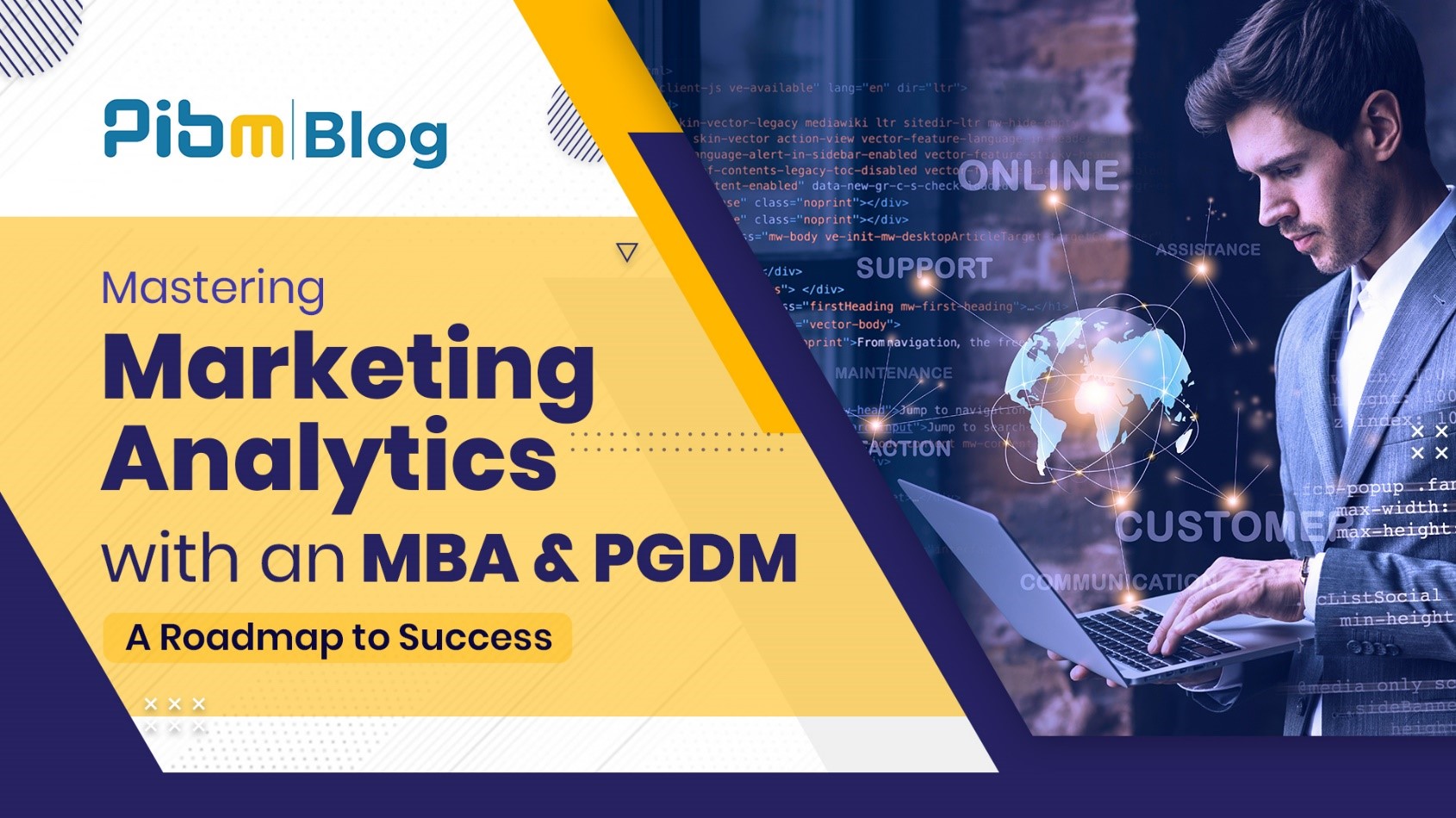PIBM Blog
Education Does Not Only
Happen in the Classroom
PIBM Blog
Mastering Marketing Analytics with an MBA & PGDM: A Roadmap to Success

Education
In today's data-driven world, marketing analytics has emerged as an essential tool for businesses to optimize their marketing strategies and drive growth. By harnessing the power of data and analytics, marketers can gain insights into consumer behaviour, measure the effectiveness of their campaigns, and make informed data-led marketing decisions.
The field of marketing analytics, which merges marketing knowledge with data analysis techniques, presents numerous career opportunities for management graduates with a PG degree like an MBA or a PGDM, who possess the ability to analyze consumer & market data, identify valuable patterns, and deliver actionable insights and recommendations.
If you are interested in building a career in Marketing Analytics, this article will provide an introduction to the domain, exploring its various techniques and applications to help you understand its significance in the modern marketing landscape.
Marketing Analytics & its Applications
Marketing analytics is the practice of collecting, analyzing, and interpreting data related to marketing campaigns and customer behaviour. It encompasses a wide range of techniques and tools used to gather information, analyze metrics. derive key insights, and make data-driven decisions to improve marketing performance for an organization. By leveraging marketing analytics, businesses can identify trends, measure the success of their marketing efforts, and refine their strategies to achieve better results.
Marketing analytics has numerous applications in the industry, enabling businesses to optimize their marketing efforts across various channels and touchpoints. Some of the key marketing analytics applications include:
Customer Segmentation and Targeting
By analyzing customer data on the basis of various parameters such as demographics, interests, behaviors, etc., businesses can identify different customer segments and tailor their marketing efforts to target each segment effectively. This helps in creating personalized marketing campaigns that resonate with the specific segment of customers and drive higher engagement with better efficiency and ROI as well ROAS.Forecasting and Budget Allocation
One of the major applications of Marketing Analytics is that it allows businesses to forecast future trends, consumer behavior, and market conditions, which can help in optimizing budget allocation and resource planning. By accurately predicting marketing outcomes, businesses can allocate their resources more effectively and make informed decisions about their marketing investments.Campaign Performance Optimization
Marketing analytics enables businesses to measure the performance of their marketing campaigns across various channels, such as social media, email, and paid search. By tracking key performance indicators (KPIs) like click-through rates, conversion rates, and return on investment (ROI), marketers can assess the effectiveness of their campaigns and make data-driven adjustments to improve results.Social Media Analytics
It also plays a vital role in monitoring and analyzing social media data. Marketing Analytics helps businesses understand customer sentiment, track brand mentions, measure engagement, and identify influential trends or individuals. By utilizing social media analytics, businesses can enhance their social media strategies, engage effectively with their target audience, and manage their online reputation.Marketing Mix Modeling
It is important for marketing leaders to assess the impact of diverse marketing activities on sales and customer acquisition. Marketing Analytics enables businesses to measure the efficiency of different marketing channels and strategies. This analysis helps organizations to optimize their marketing mix, strategically allocate resources, and make informed decisions to enhance overall marketing performance.

3 Important Types of Marketing Analytics
Marketing analytics can be broadly categorized into three main types:
Descriptive Analytics
Descriptive analytics focuses on analyzing historical data to understand past marketing performance and customer behaviour. It involves techniques like data visualization, data aggregation, and reporting to summarize marketing data and provide insights into what has happened.Predictive Analytics
Predictive analytics uses statistical models and machine learning algorithms to forecast future trends, customer behaviour, and marketing outcomes. By analyzing historical data and identifying patterns, marketers can make data-driven predictions and develop proactive strategies to capitalize on future opportunities.Prescriptive Analytics
Prescriptive analytics goes beyond predicting future outcomes by recommending specific actions businesses can take to optimize their marketing efforts. It uses advanced techniques like optimization, simulation, and decision modeling to identify the best course of action for achieving desired marketing objectives.

Pune Institute of Business Management: Empowering Marketers with Analytics Skills
The Pune Institute of Business Management (PIBM) recognizes the growing importance of marketing analytics in today's business landscape and offers a comprehensive curriculum designed to equip students with the necessary skills and knowledge. PIBM's marketing courses cover a wide range of topics, including marketing analytics techniques, tools, and applications, ensuring that students are well-prepared to navigate the data-driven world of marketing.
In addition to providing a solid foundation in marketing analytics through industry co-designed PGDM and MBA programs, PIBM emphasizes practical learning and hands-on experience, allowing students to apply their theoretical knowledge to real-world marketing challenges with the help of live business projects, real-life case studies, and dual internships. With experienced faculty, strong industry connections, and a focus on experiential learning, PIBM is an ideal destination for aspiring marketers looking to excel in the field of marketing analytics.
All in all, marketing analytics is an essential aspect of modern marketing, enabling businesses to make data-driven decisions, optimize their strategies, and drive growth. By understanding the various techniques and applications of marketing analytics, marketers can harness the power of data to unlock valuable insights and create more effective marketing campaigns. As the demand for professionals with marketing analytics expertise continues to grow, institutions like the Pune Institute of Business Management are committed to preparing the next generation of marketers for success in this rapidly evolving field.
Whether you are a seasoned marketer or a newcomer to the industry, a strong understanding of marketing analytics is crucial for staying competitive in today's data-driven world. By mastering the various types of marketing analytics – descriptive, predictive, and prescriptive –, you can gain a comprehensive view of your marketing efforts, identify areas for improvement, and devise strategies that deliver measurable results.
As you embark on your journey in the world of marketing analytics, remember that practical experience and continuous learning are key to staying ahead of the curve. By pursuing a PGDM or an MBA in Marketing Analytics from top B-schools in India, like the one offered at the Pune Institute of Business Management, you can equip yourself with the knowledge and skills needed to excel in this exciting and dynamic field.
Ultimately, marketing analytics is an indispensable tool for driving success in the modern marketing landscape and mastering its techniques and applications can unlock new opportunities for growth and innovation.








